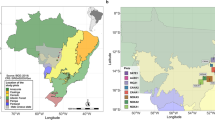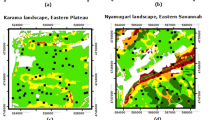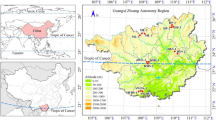Abstract
Topographic and edaphic variables are the main ecological factor determining species spatial variability on mountainous forests. A field study was performed in central Alborz to investigate how the edaphic and topographic parameters can affect the tree and shrub communities. Initially, 27 forest stands were identified and the homogeneous units were separated regarding physiognomy. In each single homogeneous unit, one random sample plot (1000 m2) and totally 43 plots were established. In each plot, the presence and abundance of all trees and shrubs were recorded and four soil samples were taken from depths of 0-5 and 5-20 cm. Concerning classification results, eight different forest communities were identified. The lowest and highest soil pH values were observed in Malus orientalis and pistacia-Amygdalus communities, respectively. The water saturation percent of pure- and mixed Juniperus excelsa and Rhus coriaria was the highest amongst communities. The clay content was the highest in pure J. excelsa. The 0-5 organic matter and Nitrogen content in mixed J. excelsa were significantly higher than pure J. excelsa and other communities. The CCA (Canonical Correspondence Analysis) results indicated that the altitude, precipitation, pH, EC, SP, clay and CaCO3 are the most important factors determine the distribution of trees and shrub in central Alborz
Similar content being viewed by others
References
Abkenar KT, Salehi A, Bagheri J, et al. (2013) Some ecological properties of Pistacia atlantica Desf. in Khojir National Park of Iran. Chinese Journal of Applied and Environmental Biology 19(3): 415–420. DOI: 10.3724/SP.J.1145.2013.00415
Ahmed M, Husain T, Sheikh AH, et al. (2006) Phytosociology and structure of Himalayan forests from different climatic zones of Pakistan. Pakistan Journal of Botany 38(2): 361–383.
Akhani H, Mahdavi P, Noroozi J, et al. (2013) Vegetation patterns of the irano-turanian steppe along a 3000 m altitudinal gradient in the Alborz mountains of Northern Iran. Folia Geobotanica 48(2): 229–255. DOI: 10.1007/s12224-012-9147-8
Baniya CB, Solhøy T, Gauslaa Y, et al. (2012) Richness and composition of vascular plants and cryptogams along a high elevational gradient on Buddha Mountain, Central Tibet. Folia Geobotanica 47(2): 135–151. DOI: 10.1007/s12224-011-9113-x
Bouyoucos GJ (1962) Hydrometer method improved for making particle size analyses of soils. Agronomy Journal 54(5): 464–465.
Bremner JM, Mulvaney CS (1982) Nitrogen-total. In: Page A, Miller R, Keeney D (eds.), Methods of soil analysis, part 2: chemical and microbiological properties. Soil science society of America and American society of Agronomy, Madison, Wisconsin, USA. pp 595–624.
Chiarucci A, Robinson BH, Bonini I, et al. (1998) Vegetation of Tuscan ultramafic soils in relation to edaphic and physical factors. Folia Geobotanica 33: 113–131. DOI: 10.1007/BF02913340
Hanba YT, Noma N, Umeki K (2000) Relationship between leaf characteristics, tree sizes and species distribution along a slope in a warm temperate forest. Ecology Research 15: 393–403. DOI: 10.1046/j.1440-1703.2000.00360.x
Hati KM, Biswas AK, Bandyopadhyay KK, et al. (2007) Soil properties and crop yields on a vertisol in India with application of distillery effluent. Soil and Tillage Research 92(1): 60–68. DOI: 10.1016/j.still.2006.01.011
Huo H, Feng Q, Su YH (2015) Shrub communities and environmental variables responsible for species distribution patterns in an alpine zone of the Qilian Mountains, northwest China. Journal of Mountain Science 12(1): 166–176. DOI: 10.1007/s11629-014-3126-x
Kammer PM, Schöb C, Eberhard G, et al. (2013) The relationship between soil water storage capacity and plant species diversity in high alpine vegetation. Plant Ecology & Diversity 6(3-4): 457–466. DOI: 10.1080/17550874.2013.783142
Kargioglu M, Tatli A (2005) A phytosociological research on the forest vegetation of Yandag (Isparta-Turkey). Pakistan Journal of Biological Science 8: 929–939. DOI: 10.3923/pjbs. 2005.929.939
Kent M, Coker P (1994) Vegetation description and analysis: A practical approach. Wiley, Chichester, UK. p 428.
Klein JC (2001) La Vegetation Altitudinale de L’Alborz Central (Iran). Institut Francais de Recherche rn Iran, Peeters, Louvain. pp 376.
Kleine M, Colak AH, Kirca S, et al. (2009) Rehabilitation degraded forest landscapes in West and Central Asia, a synthesis. In: Lee DK, Kleine M (eds) KeepAsia green, vol IV “West and Central Asia”. IUFRO World Series, IUFRO, Vienna, Austria. vol 20-IV, pp 5–25.
Leps J, Smilauer P (1999) Multivariate analysis of ecological data. Faculty of Biological Sciences, University of South Bohemia, Ceské Budejovice. p 110.
McAlpine KG, Jesson LK (2008) Linking seed dispersal, germination and seedling recruitment in the invasive species Berberis darwinii (Darwin’s barberry). Plant Ecology 197(1): 119–129. DOI: 10.1007/s11258-007-9365-y
McCune B, Mefford MJ (1999) PC-ORD. Multivariate Analysis of Ecological Data, Version 4. MjM Software Design, Gleneden Beach, Oregon, USA.
Pourmajidian MR, Moradi M (2009) Investigation on the site and silvicultural properties of Juniperus excelsa in natural forests of Ilan in Qazvin province. Iranian Journal of Forest and Poplar Research 17(3): 475–487. (In Persian)
Ne’eman G, Lahav H, Izhaki I (1992) Spatial pattern of seedlings 1 year after fire in a Mediterranean pine forest. Oecologia 91(3): 365–370. DOI: 10.1007/BF00317625
Nelson DW, Sommers LE (1996) Total carbon, organic carbon, and organic matter. In: Sparks DL (ed.): Methods of soil analysis. Part 3: Chemical methods. Soil Science Society of America Book Series Number 5. American Society of Agronomy, Madison, USA. pp 961–1010.
Noroozi J, Akhani H, Willner W (2010) Phytosociological and ecological study of the high alpine vegetation of Tuchal Mountains (Central Alborz, Iran). Phytocoenologia 40(4): 293–321. DOI: 10.1127/0340-269X/2010/0040-0478
Orloci L (1978) Multivariate analysis in vegetation research. Dr. W. Junk Publisher, The Hague, Boston, USA. p 491.
Ozkan K, Gulsoy S, Aerts R, Muys B (2010) Site properties for Crimean juniper (Juniperus excelsa) in semi-natural forests of south western Anatolia, Turkey. Journal of Environmental Biology 31: 97–100.
Page AL (1992) Methods of soil analysis. ASA and SSSA Publishers, Madison, USA. p 321.
Pinto SIDC, Martins SV, de Barros NF, et al. (2007) Influence of environmental variables on the shrub and tree species distribution in two Semideciduous Forest sites in Viçosa, Minas Gerais, Brazil. International Journal of Tropical Biology and Conservation 56(3): 1557–1569. DOI: 10.15517/rbt.v56i3.5729
Plaster EJ (1985) Soil science and management. Albany, NY: Delmar Publishers Inc. p 124.
Ravanbakhsh H, Marvi Mohajer MR, Zahedi Amiri Gh, et al. (2010) Forest typology in relation with altitudinal gradient on southern slopes of the central Alborz Mountains (Latian Dam Watershed), Journal of Forest and Wood Products (JFWP) 63(1): 9–22. (In Persian)
Ravanbakhsh H, Hamzeh’ee B, Etemad V, et al. (2015) Phytosociology of Juniperus excelsa M. Bieb. forests in Alborz mountain range in the north of Iran. Plant Biosystems, (ahead-of-print) 1–14. DOI:10.1080/11263504.2014.1000420
Rezaipor M, Jehani H, Hoseini SM, et al. (2014) Ecological survey Rhus coriraria L. shrub in west of Iran, Journal of Plant Researches (Iranian Journal of Biology) 26(4): 444–452. (In Persian)
Roces-Díaz JV, Jiménez-Alfaro B, Álvarez-Álvarez P, et al. (2015) Environmental niche and distribution of six deciduous tree species in the Spanish Atlantic region. iForest-Biogeosciences and Forestry 8: 214–221. DOI: 10.3832/ifor1183-008
Sabeti H (1994) Forests, trees and shrubs of Iran. University of Yazd, Iran. p 810. (In Persian)
Sarangzai AM, Ahmed M, Ahmed A, et al. (2012) The ecology and dynamics of Juniperus excelsa forest in Balochistan-Pakistan. Pakistan Journal of Botany 44(5): 1617–1625.
Sardans J, Peñuelas J (2013) Plant-soil interactions in Mediterranean forest and shrublands: impacts of climatic change. Plant and soil 365(1-2): 1–33. DOI: 10.1007/s11104-013-1591-6
Sarvade S, Gupta B, Singh M (2016) Composition, diversity and distribution of tree species in response to changing soil properties with increasing distance from water source–a case study of Gobind Sagar Reservoir in India. Journal of Mountain Science 13(3): 522–533. DOI: 10.1007/s11629-015-3493-y
Sevruk B (1997) Regional dependency of precipitation-altitude relationship in the Swiss Alps. Climatic Change at High Elevation Sites, Springer Netherlands. pp 123–137. DOI: 10.1007/978-94-015-8905-5_7
Siefert A, Ravenscroft C, Althoff D, et al. (2012) Scale dependence of vegetation–environment relationships: a meta-analysis of multivariate data. Journal of Vegetation Science 23(5): 942–951. DOI:10.1111/j.1654-1103.2012.01401.x
Shamohamadi O, Asri Y, Khaniki GB, et al. (2015) Investigation on Habitat demands of Malus orientalis Ugl. in Zagros forests (case study: Divandareh, Kurdestan). Biological Forum 7(1): 446.
Sagheb-Talebi Kh, Sajedi T, Pourhashemi M (2014) Irano-Turanian Region in Forests of Iran. Springer Netherlands. pp 67-113. DOI: 10.1007/978-94-007-7371-4_3
ter Braak CJF (1986) Canonical correspondence analysis: a new eigenvector technique for multivariate direct gradient analysis. Ecology 67: 1167–1179. DOI: 10.2307/1938672
ter Braak CJF (1987) The analysis of vegetation-environment relationships by canonical correspondence analysis. Theory and models in vegetation science. Springer Netherlands. pp 69–77. DOI: 10.1007/978-94-009-4061-1_7
ter Braak CJF, Smilauer P (2002) CANOCO reference manual and CanoDraw for Windows user’s guide: software for canonical community ordination (version 4.5). Biometris-Plant Research International, Wageningen, the Netherlands.
Zamani SM, Zolfaghari R & Alvaninejad S (2014) Relationship between ecological species groups and environmental factors in protected area of Dena. Journal of Forest and Wood Products 67(2): 255–269. (In Persian)
Zohary M (1973) Geobotanical Foundation of the Middle east. G. Fischer, Stuttgart. p 738.
Author information
Authors and Affiliations
Corresponding author
Additional information
http://orcid.org/0000-0003-0990-0112
http://orcid.org/0000-0001-5515-7505
Electronic supplementary material
Rights and permissions
About this article
Cite this article
Ravanbakhsh, H., Moshki, A. The influence of environmental variables on distribution patterns of Irano-Turanian forests in Alborz Mountains, Iran. J. Mt. Sci. 13, 1375–1386 (2016). https://doi.org/10.1007/s11629-015-3789-y
Received:
Revised:
Accepted:
Published:
Issue Date:
DOI: https://doi.org/10.1007/s11629-015-3789-y




